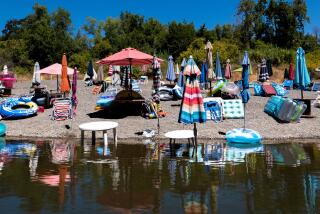Boys’ Drownings Revive Debate on L.A. River Safety
- Share via
On the day Derrick Ashe and Ray Wells drowned in the Los Angeles River, little stood between the Long Beach third-graders and their fate. At the levee, they either walked through an open gate or squeezed through a gap in the iron fence, which has no warning signs along its length.
After they climbed the bank and crossed the bike trail, the only barrier to the water was a 3- to 4-foot concrete wall. They hopped over it, leaving their Razor scooters behind before clambering down the slope.
Nothing could stop them last week--not even the advice of Derrick’s father to stay out of the river. Parker Ashe recalled that he reminded his son so many times that the boy finally said, “ ‘OK, Dad, you don’t have to say it no more.’ ”
Now Derrick and Ray are dead, the latest victims of the 58-mile Los Angeles River, a once temperamental waterway that has been transformed into the core of the region’s vast flood control network.
“It’s a dangerous place. . . . They ought to make it harder for kids to get in,” Ashe said as he prepared for his son’s funeral, to be held Saturday. “This has been a real lesson for all the parents over here.”
In the aftermath of the drownings, Ashe has rekindled the debate over the safety of the Los Angeles River at a time when the county’s main flood control channels are being increasingly opened up for recreation, such as hiking and bicycling.
Advocates of more public access, including environmental groups, say additional precautions are necessary, including well-placed warning signs and security fences higher than the current five feet.
“It’s real easy to get in. I’ve even seen people in the river when everything was supposedly locked down for a storm,” said Joan Greenwood, a member of the board of Friends of the Los Angeles River, a conservation group trying to restore the waterway.
Greenwood--who describes the river as an “attractive nuisance”--said that during public meetings in the mid-1990s, she repeatedly told Long Beach officials and the Army Corps of Engineers that better safety measures were needed. But she said the authorities did not go far enough with the recommendations.
“The fencing is fine, but it should be taller. There are no signs and that is a concern. There are places to get through, even when the gates are locked,” Greenwood said. “The drownings just underscore the fact that the river is no place for children.”
Chris Stone, a county public works employee and former project manager for the Los Angeles River, said he does not recall Greenwood’s ever having discussed the safeguards. He said environmental groups wanted more access, not more restrictions.
County officials responsible for maintaining the region’s flood control system say the network of open channels is reasonably safe. During heavy rains, the waterways are closed to the public, they say, and rescue techniques have been vastly improved.
Rather than rely on signs and elaborate barriers, officials say, they have developed educational programs for public schools to warn students annually about the hazards of flood control channels.
“The system is safe,” said Diego Cadena, who is in charge of the county’s flood maintenance division. “But, you know the old saying, ‘Where there’s a will, there’s a way.’ People who want to get into the river can find a way to do it.”
Part of the annual educational effort got underway Wednesday at Castaic Lake, where firefighters and lifeguards from around the Southland demonstrated rescue techniques and issued a formal warning to the public.
“We want to get the word out that when the rains come, people who get in the channel can get trapped,” said Capt. Brian Jordan of the Los Angeles County Fire Department. “Suddenly they’re being carried down the river at 35 mph and they can’t get out.”
On average, about 100 people drown every year in the county, six of them in flood control channels, particularly the Los Angeles River, which has been straitjacketed into a concrete waterway. Among the dead have been the homeless, construction workers, children, would-be rescuers and a young woman whose supposed boyfriend abandoned her after she fell in.
Lifesaving Techniques
Perhaps the most dramatic case was the drowning of 15-year-old Adam Bischoff, who was swept to his death in the rain-swollen Los Angeles River in 1992. Dozens of potential rescuers who chased him from bridge to bridge could not save him as he hurtled by at speeds as high as 35 mph.
Adam’s death prompted improvements in lifesaving techniques, including the creation of the county’s swift-water rescue team. Film of his plight also became part of a 20-minute video called “No Way Out,” which is shown annually in public schools. It was co-produced by Nancy Rigg, whose fiance, Earl Higgins, died in the Los Angeles River in 1980 while trying to rescue a child.
Though the drownings are tragic, county officials point out that the numbers are small, considering the size of the flood control system, which has 470 miles of open channels, 2,400 miles of covered storm drains, 123 debris basins and 20 dams.
They say that, before the flood control system was built in the 1940s, scores of people died when the county’s rivers overflowed during heavy storms. In 1938, flooding killed at least 113 people.
Much of the system is fenced with either wrought iron or chain-link barriers. During storms or other times of high water, gates along the waterways are padlocked and the county dispatches roving patrols.
Cadena said a two-person team is permanently assigned to repair holes that people continually cut in the fences to gain access to the water. Along the stretch of river where the two boys died on Oct. 25, there are at least two gaps where people can enter.
Except for the winter months, the water flow in the county’s rivers, officials say, generally does not pose a drowning risk, except for weak swimmers or nonswimmers. Long Beach officials say the river was not dangerously turbulent when Derrick and Ray fell in. The city’s chief lifeguard speculated that the boys were either weak swimmers or nonswimmers.
But even during storms, the county posts “No Trespassing” signs only at the gates to flood control channels. While there are plenty of no-parking and no-dumping signs along the river, no other warnings exist. Officials contend that warning signs are no deterrent.
“We can’t completely prevent drownings. We can only control them to a certain extent,” said Jim
Wells, a spokesman for the Los Angeles Fire Department. “The number of fatalities is minimal, but even one fatality can be one too many.”
Wells and other public safety officials say that education, parental advice and announcements in the news media are perhaps the most practical measures, given the drive to open the waterways more to the public. But they stop short of saying what the best solution is for parents.
“Kids need to be warned, yet kids are kids and parents can’t always be there 24 hours a day,” said Mark Boone, the chief of lifeguards for Long Beach. “Grab any child and they’ll tell you that they are not supposed to go in the river, but you turn around and there they are. I just don’t have the answer.”
*
Times staff writer Carol Chambers contributed to this story.
More to Read
Sign up for Essential California
The most important California stories and recommendations in your inbox every morning.
You may occasionally receive promotional content from the Los Angeles Times.










